Responding to Senator Bond on New START

Senator Kit Bond, Republican of Missouri, gave a speech in the Senate on the New START treaty. Eli Lake’s summary is in the Washington Times. He made accusations of serious shortcomings in the treaty. I address these points because they appear to be substantive and earnest, unlike some of the hysteria and outright silliness coming from other treaty opponents. I believe that the Senator’s concerns are sincere but that does not make them correct. They reflect, instead, shortcomings in understanding about the treaty, misrepresentation of exiting U.S. and Russian nuclear forces, and a mistake in statistics.
Bond claims of the treaty’s limits on missile defense are spurious. The only limit the treaty places on defenses is that neither Russia nor the United States can use existing offensive launchers to house defensive missiles. The United States has no plans to do such a thing so the treaty keeps us from doing something we do not want to do. If the treaty forbid us from painting our defensive missiles purple, would anyone object? (I suppose, the answer is “yes.”)
He also objects to Moscow’s unilateral statements that it can reevaluate offensive arms limitations if U.S. defenses threaten to defeat Russian retaliatory capability. This issue is more subtle than it is serious. First, either side can say whatever it likes but the treaty is what it is. Moreover, the U.S. is unlikely to have the necessary defensive capability within its technical reach in the imaginable future but, even so, to say, as the preamble of the treaty does, that there is a connection between offense and defense should be an obvious statement of fact. Indeed, why would we be spending billions on a missile defense system that is unconnected to offensive missiles? Finally, he claims that Russian threats to abandon the treaty are leverage over U.S. defensive plans. There is no treaty that we, or the Russians or any other nation, can sign up for that cannot be repudiated. But that is our decision, not the Russians, to decide whether that is leverage or not. The U.S did withdraw from the ABM treaty in 2001 with strong support from the conservatives in Congress. It is a fact of life, not a criticism of treaties or this treaty in particular.
Senator Bond also objects that the treaty allows deployed missiles to be rapidly uploaded with additional warheads. This is, in fact, a big concern about the treaty, but it is a concern the Russians have about the U.S., not the other way around. The Russians pushed for lower launcher limits while we pushed for lower warhead limits. The U.S. gets down to the warhead limit in part by off-loading warheads from multiple warhead missiles on its submarines, so the US has lots of empty launch spots on its missiles. (This is precisely why Russia pushed for lower launcher numbers. See discussion in the next paragraph.) The problem Senator Bond points out is precisely the problem that Russia sees when looking at US systems. The Russians, with lower launcher numbers, will be much closer to their maximum missile loading than the US will be. If Russia breaks out of the treaty, which they cannot do undetected, the U.S. is in a far stronger position to react than Russia is to act. Russia knows this, making this breakout tactic unappealing to them.
The Senator’s misleadingly claims that “ this treaty … forces the United States to reduce unilaterally our forces, such as missiles, bombers, and warheads, in order to meet treaty limits. On the other hand, the Russians will actually be allowed to increase their deployed forces because they currently fall below the treaty’s limits.” As shown in the graph above, prepared by my colleague Hans Kristensen, we see that the US makes almost no reductions from current numbers of launchers and warheads. (Indeed, talk of how the treaty demands a reduction of third in deployed warheads is overstated because current counting rules overstate the actual number of warheads. There is a one third reduction in accounted warheads, but not in actual warheads.) The Russians have to make significant reductions in warhead numbers. Perhaps what the Senator is referring to is that Russia’s launcher number is below the limit and the Russian’s current plans are to cut launchers even further below New START limits anyway, so they could build up launchers from where they are expected to be. But this is just to say that the treaty favors the U.S. because we are going to exploit both the launcher and warhead limits to the fullest but the Russians will not. The alternative seems to be to further restrict U.S. launchers to get them down to where Russia is. How does that make the treaty stronger? The bottom line is that Russian warhead numbers have to come down. And it is warheads, not missiles that blow things up. (Note that in both cases, the deployed warhead numbers are above the treaty “limit” because of the counting rule on bombers.) We can be absolutely certain that the Russians pushed for a launcher limit that was as low as where they were heading anyway. The fact the launcher limit is higher, where the Americans, not the Russians, want it to be, is a sign of successful U.S. negotiation, not a weakness of the treaty.
Senator Bond’s statements that the treaty requires unilateral reduction in the number of bombers is flatly wrong. Indeed, each U.S. bomber, which can carry a dozen nuclear bombs, is counted as though it carries only one, which is considered a major shortcoming by those of us who wanted a more ambitious treaty.
When he says that “unlike START” this treaty places no limit on non-deployed missiles he is overstating the limits of START. The 1991 treaty did place some limits on certain Russian mobile missiles, for example, but it only limited launchers for fixed ICBMs and for SLBMs, not the missiles that went into those launchers. When Bond argues that START allowed us to count warheads precisely because we could count launchers precisely and had a warhead counting rule, he is again mistaken. We counted launchers as a surrogate for missiles and those were a surrogate for warheads. (We counted launchers not because it was a great idea but, given limitations on monitoring, it was the only thing we could count.) True, at the end you come up with a nice precise number that everyone can agree on but that number is only indirectly related to the actual number of warheads. That has been perceived by most as a major weakness of past arm control verification schemes that New START rectifies. It is clear that Senator Bond actually prefers missile limits with counting rules to counting warheads directly, apparently because that is a better measure of the worst case. That is a valid objection but most nuclear planners would rather have a direct count on warhead numbers than have an exact count on launchers that are a surrogate for a surrogate for warhead numbers that might be off by a third. It is important to note that the Russians actually have limited capacity for the breakout that Bond worries about and it could not occur undetected.
The Senator misunderstands statistics and the purpose of inspections: he says that the 10 inspections a year will only check on 2 percent of the Russian forces, the implication being that 98% will be a complete mystery to us so we really don’t have any idea what is going on. This is not true: with just a sampling provided by inspections, we can have extremely high confidence in compliance.
As he says, “…these inspections cannot provide conclusive evidence of whether the Russians are complying with the warhead limit.” True, checking on 10 weapons sites is not enough to develop a statistical picture of Russian forces. But the treaty requires data exchanges to declare how many warheads are on which missiles. The data exchanges include the entire arsenal on both sides. The inspections are not really to inspect the weapons themselves so much as to confirm the data exchanges. Say the Russians wanted to cheat by putting more warheads than allowed on, say, 10% of their missiles. (I pick 10% because I don’t think anyone is arguing that 10% more or fewer weapons will make any discernable military difference. The number of warheads we have ready to launch changes by about 10% every time a ballistic missile submarine goes on or off patrol.) They would have to put the warheads on missiles and then lie on the data exchange and hope they don’t get caught. So, if we pick our inspection sites randomly, then there is a 10% chance they will get caught in one inspection and a 90% chance they will get away without detection on that one inspection. But there is only an 81% chance of getting past two inspections, 73% chance away with three, and so on. If we do 10 inspections, there is a 2/3 chance we will catch a violation of only a 10% cheat, hardly odds that would appeal to a prospective cheater. There is a 90% chance we would catch a 20% cheat. Just in the first 10 inspections. Remember that inspections continue over the years and our confidence will increase over time, approaching near certain that even small violations will be detected by the time the warhead limits are reached. Compare this to our complete lack of knowledge of warhead numbers without inspections.
Note that the important number is the number of inspections, not the fraction of sites inspected. The statistics are essentially the same whether we inspect ten out of a hundred sites or ten out of ten thousand. Therefore, the Senator’s point that the inspections look at only 2-3% of the sites is wholly irrelevant from a mathematical perspective.
It is also important to understand that, contrary to Senator Bond’s implication, our National Technical Means, that is, overhead satellites, do not suddenly disappear. If the Russians tried to quickly load more warheads on missiles, we would see it.
Senator Bond’s objections are not simply politically motivated hysteria but his objections have been addressed and met. The treaty will reduce the nuclear threat and the verification is carefully tailored to meet the provisions of the treaty. Ratify.
NATO Strategic Concept: One Step Forward and a Half Step Back
 |
| NATO General Secretary Anders Fogh Rasmussen presents the alliance’s new Strategic Concept |
By Hans M. Kristensen
The new Strategic Concept adopted today by NATO represents one step forward and a half step backward for the alliance’s nuclear weapons policy.
The forward-leaning part of the nuclear policy pledges to actively try to create the conditions for further reducing the number of and reliance on nuclear weapons, recommits to the ultimate goal of nuclear disarmament, and reaffirms that circumstances in which the alliance could contemplate using its nuclear weapons are “extremely remote.”
But the strategy fails to present any steps that reduce the number of or reliance on nuclear weapons. As such, the new Strategic Concept – Active Engagement, Modern Defence – falls short of the Obama administration’s recent Nuclear Posture Review.
Even so, there are important changes in the document that hint of things to come.
The Role of Nuclear Weapons
The new Strategic Concept does not explicitly reduce the role of NATO’s nuclear weapons. Instead, it echoes the Obama administration’s formulation that “as long as nuclear weapons exist,” NATO will remain a nuclear alliance.
And the formulation in the 1999 Strategic Concept that “NATO’s nuclear forces no longer target any country” is gone from the new document. Instead, it states that NATO “does not consider any country to be its adversary.”
Overall, the 2010 document is far less explicit than the 1999 document about what the role of nuclear weapons is. The previous document explicitly described the role “to preserve peace and prevent coercion and war of any kind…by ensuring uncertainty in the mind of any aggressor about the nature of the Allies’ response to military aggression,” and “demonstrate that aggression of any kind is not a rational option.”
The new document, in contrast, describes the role of nuclear weapons in very general terms, essentially with no specifics, and as part of an overall mix of nuclear and conventional capabilities.
Gone is the previous language about U.S. tactical nuclear weapons in Europe providing an essential political and military link between Europe and North America, or that sub-strategic forces provide a link with strategic forces.
Instead, the document states that it is the strategic forces of the United States, in particular, and to some extent Britain and France, that provide the “supreme guarantee of the security of the Alliance”.
US Nuclear Forces in Europe
Combined, these significant changes could be seen as hints of an attempt to lessen the importance the alliance attributes to having U.S. tactical nuclear weapons forward deployed in Europe.
To be sure, the document still contains what appears to be a commitment to some form of U.S. nuclear presence in Europe, by committing to “the broadest possible participation of Allies in collective defence planning on nuclear roles, in peacetime basing of nuclear forces, and in command, control and consultation arrangements.” (Emphasis added)
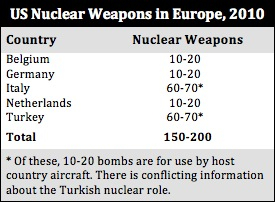 |
But this is vague language compared with the 1999 document. It could simply be met by Allies taking part in Nuclear Planning Group meetings, deployment of some U.S. dual-capable aircraft in Europe but without weapons, and Allies continuing to be part of the decision making process for potential use of nuclear weapons.
The number of U.S. nuclear weapons in Europe today is down to 150-200 B61 bombs deployed at six bases in five countries (see table).
The Role of Russia
In the years between the 1999 and 2010, NATO unilaterally reduced the number of U.S. tactical nuclear weapons deployed in Europe by more than half, from 480 to 150-200 B61 bombs. The 1999 Strategic Concept did not mention Russia at all as a factor for sizing the U.S. deployment.
The new Strategic Concept, in contrast, returns Russia to a central position for how the Alliance sizes the number of U.S. nuclear weapons deployed in Europe.
“In any future reductions,” NATO declares, “our aim should be to seek Russian agreements to increase transparency on its nuclear weapons in Europe and relocate these weapons away from the territory of NATO members.”
Moreover, “Any further steps must take into account the disparity with the greater Russian stockpiles of short-range nuclear weapons.”
While seeking to achieve reductions in Russian tactical nuclear weapons is important – it has more than 5,000 of them, formally linking the U.S. deployment in Europe to Russia seems to contradict the policy of the past two decades that the U.S. weapons in Europe are not directed against Russia. And NATO has repeatedly made unilateral reductions without demanding Russian reductions. Indeed, the new Strategic Concept declares that “NATO poses no threat to Russia,” and that the Alliance “does not consider any country to be its adversary.”
So to begin now to argue that the size of the U.S. arsenal in Europe is linked to Russia after all resembles the Cold War policy when NATO looked to Russia for sizing the U.S. arsenal in Europe.
Moreover, Russia’s tactical nuclear weapons posture is less tied to the U.S. nuclear posture in Europe and more to Russia’s perception of countering NATO’s superior conventional forces and defending the long border with China. Since those factors determine the size of the large Russian tactical nuclear weapons arsenal, it is hard to see why Moscow would agree to reduce its tactical nuclear weapons in return for reductions of U.S. tactical nuclear weapons in Europe.
The Future
The changes in the new Strategic Concept are many and important. The language could hint that NATO may be preparing the ground for the withdrawal of U.S. nuclear weapons from Europe. But the way forward is muddled with preconditions on Russian reductions.
A joint communiqué from the Lisbon Summit might make things clearer tomorrow but it will require a new deterrence review in 2011 for NATO to translate what the Strategic Concept means for NATO’s nuclear posture.
Conditioning future reductions on Russia could be a roadblock, so hopefully the vague “aim to seek” and “taking into account” formulations don’t imply tit-for-tat reciprocity. The success of the unilateral withdrawals in the early 1990s suggests that a unilateral withdrawal of U.S. nuclear weapons from Europe would be more effective in stimulating a Russian response.
The Obama administration sees the emergence of a “new, tailored, regional deterrence architecture” that “make[s] possible a reduced role for nuclear weapons in our national security strategy.” The new Strategic Concept seems to agree, so hopefully the Obama administration can now become more assertive in pushing for a withdrawal of the last U.S. tactical nuclear weapons from Europe so it can focus on an agreement to reduce U.S. and Russian tactical nuclear weapons in general.
This publication was made possible by a grant from Carnegie Corporation of New York and Ploughshares Fund. The statements made and views expressed are solely the responsibility of the author.
New START Delay: Gambling With National and International Security
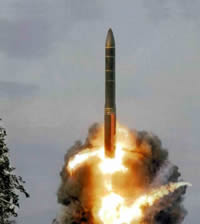 |
| A few Senators are preventing US inspectors from verifying the status of Russian nuclear weapons. |
By Hans M. Kristensen
The ability of a few Senators to delay ratification of the New START treaty is gambling with national and international security.
At home the delay is depriving the U.S. intelligence community important information about the status and operations of Russian strategic nuclear forces. And abroad the delay is creating doubts about the U.S. resolve to reduce the number and role of nuclear weapons, doubts that could undermine efforts to limit proliferation.
New START may not be the most groundbreaking treaty ever, but it is a vital first step in moving U.S.-Russian relations forward and paving the way for additional nuclear reductions and nonproliferation efforts. Essentially all current and former officials and experts recommend verification of New START, and after more than 20 hearings and nearly 1,000 detailed questions answered it is time for the Senate to ratify the treaty.
Important Inspections
Ratification would set in motion a wide range of data exchange and on-site inspection activities. By delaying ratification, the Senators are depriving the U.S. intelligence community important information about Russian nuclear forces. Apart from monitoring how Russian strategic nuclear forces are evolving and operating, the information is important to avoid worst-case threat assessments that can negatively affect U.S.-Russian relations.
It has now been 348 days since the last U.S. inspection team left Russia.
During the 15 years the START Treaty was in effect between 1994 and 2009, U.S. teams conducted 659 inspections of Russian nuclear weapons facilities; Russian conducted 481 inspections of U.S. facilities.
The last U.S. on-site inspection took place on November 18-19, 2009, at an SS-25 mobile missile base near Teykovo, approximately 130 miles (210 km) northeast of Moscow.
.
That inspection had special meaning because the SS-25 is being phased out from this area and replaced with the new SS-27. While each SS-25 is equipped with one warhead, the SS-27 comes in two versions: one with a single warhead and one with three warheads. The U.S. intelligence community calls the latter the SS-27 Mod 2, while the Kremlin named it RS-24 so as to avoid conflict with the now expired START treaty.
One of the four bases at Teykovo has already been equipped with the SS-27 Mod 2, two still have the SS-25, while the fourth base has been emptied and might be converting to the newer missile. Within the next decade, all four bases may be equipped with the SS-27 Mod 2.
The Russians chose Whiteman Air Force Base in Missouri for their final on-site inspection in the United States. That inspection took place on December 1-2, 2009, just two days before the treaty expired.
| B-2 of the 509th Bomb Wing over Whiteman AFB |
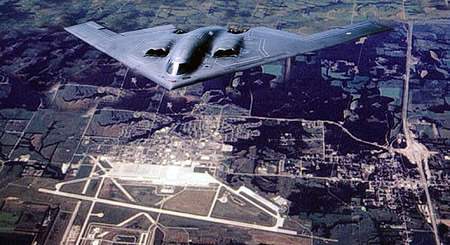 |
| Russia chose the B-2 base at Whiteman Air Force Base as its final inspection in the United States under the now expired START treaty. |
.
The Nonproliferation Gamble
From the outset, the Obama administration appears to have seen Russia as the main potential obstacle to the treaty, rather than the U.S. Senate. Absent a strategy to secure the votes for ratification early on, the tables have now turned; with the White House desperate to secure ratification, a few Senators who still see Russia through Cold War lenses have effectively managed to use hearings and voting rules to extort concessions (read: money) from the administration to modernize the nuclear weapons production complex and delivery systems.
| Senator Jon Kyl |
 |
| A few senators, most prominently Senator Jon Kyl (R-Arizona), have managed to delay ratification of the New START treaty. |
.
The administration quickly agreed to boost the FY 2011 budget for the National Nuclear Security Administration (NNSA) well above the FY 2010 level. But that didn’t satisfy the Senators. So when Congress was unable to approve the budget before the mid-term election, the administration agreed that a Continuing Resolution (CR) designed to keep federal agencies operating at FY2010 budget levels through December 3rd would include an exemption for NNSA’s weapons program to fund the agency at the higher FY 2011 budget request – about $7 billion or an additional $625 million. But since the provisions in the defense appropriations bill and report don’t apply to the CR, the appropriators have lost control of how the funds are used; Congress is basically providing NNSA with a blank check to spend the $7 billion.
In addition, in an effort to buy the Senators’ votes for ratification during the “lame duck” session before the new Congress begins, the administration has offered $600 million more for the FY 2012 NNSA budget above FY 2011 levels, as well as an additional $3.6 billion spread out over FY 2013-2016.
Altogether, in a nuclear spending spree that would have been inconceivable during the Bush administration, the Obama administration plans to spend well over $180 billion to modernize nuclear weapons delivery systems and production facilities over the next decade.
There is a real risk that in the coming years, this modernization could backfire and undermine the second pillar of U.S. nuclear policy: strengthening nonproliferation.
The reason is simple: U.S. nonproliferation efforts dependent upon international support, but if the international community sees the increased nuclear modernizations as contradicting the U.S. pledge to work toward nuclear disarmament, some countries may well decide not to support the administration’s nonproliferation agenda.
This risk could be compounded later this week if NATO approves a new Strategic Concept that reaffirms the importance of nuclear weapons – and fails to order the withdrawal of the remaining tactical nuclear weapons from Europe.
The Senate needs to demonstrate that it understands that the Cold War is over and that it cares more about national and international security than politics by ratifying the New START treaty before Christmas. And the administration must be careful to balance its nuclear modernization plans with the need to sustain the vision of nuclear disarmament that so inspired the international community just 18 months ago.
This publication was made possible by a grant from Carnegie Corporation of New York and Ploughshares Fund. The statements made and views expressed are solely the responsibility of the author.
START in a Lame Duck
 |
| The Senate should vote on the New START during the “lame duck” session. |
The New START arms control treaty, negotiated between the United States and Russia and signed by the presidents of both countries last April, is awaiting ratification by the United States Senate. Objections to the treaty rest primarily upon misunderstandings or misrepresentation. In addition, though, some opponents of the treaty are arguing that, whether one supports or opposes the treaty, it is improper for the Senate to vote on the treaty during the post-election or “lame duck” session of Congress. But there is neither a constitutional nor a commonsense reason to delay a vote.
Some of us who hope to dramatically and rapidly reduce the salience of nuclear weapons were disappointed that the treaty was rather modest, but it clearly moves in the right direction. This treaty is not a radical departure from past treaties, it is not even a post-Cold War treaty; it is an extrapolation of the Cold War SALT and START treaties stretching back to the days of the Soviet Union. Given the current strategic security environment, neither Richard Nixon, nor Ronald Reagan, nor George H. W. Bush would blink an eye at this treaty. (more…)
Chinese Nuclear Forces 2010
 |
.
By Hans M. Kristensen
It’s interesting scary what you can find on the Internet: On Thursday, a Canadian calling himself SinoSoldier posted a report on the Pakistani web site Pakistan Defense claiming that China had test launched a JL-3 submarine-launched ballistic missile (SLBM) from a submarine in the Atlantic (!). Different versions allegedly have ranges from 12,000 km to 20,000 km and carry 5-7 warheads as opposed to 10 on the JL-2 SLBM. The source was said to be a report in the Japanese newspaper Yomiuri Shimbun.
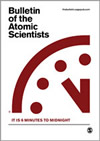 |
| Click image to download |
I haven’t been able to find the original story, but the report in Pakistan Defense is completely wrong: China does not have a JL-3 missile; it does not have a Type 096 submarine; it has never operated a submarine in the Atlantic; its two types of SLBMs (JL-1 and JL-2) have ranges of 1,770 km and 7,200 km, respectively; and they are only equipped with one warhead each.
The flaws in the report unfortunately did not prevent it from being picked up by Undersea Enterprise News Daily, an email newsletter distributed by the U.S. Atlantic submarine fleet headquarters.
Instead, check out our latest Nuclear Notebook on Chinese nuclear forces, just published for the Bulletin of the Atomic Scientists by Sage Publications: Chinese Nuclear Forces, 2010 (pdf version)
This publication was made possible by a grant from Carnegie Corporation of New York and Ploughshares Fund. The statements made and views expressed are solely the responsibility of the author.
Nonsense about New START and ICBMs
Because of what appears to have been a computer glitch, a group of nuclear-armed intercontinental ballistic missiles (ICBMs) was temporarily off-line last week and not ready to launch on a moment’s notice. According to an article in The Atlantic, some Republicans have suggested that this means that New START, the nuclear arms control treaty awaiting Senate ratification, is unwise and should be rejected. This assertion is nonsense but is a useful illustration of how much of current nuclear “thinking” is just a holdover from now irrelevant Cold War doctrine. (more…)
Scrapping the Unsafe Nuke
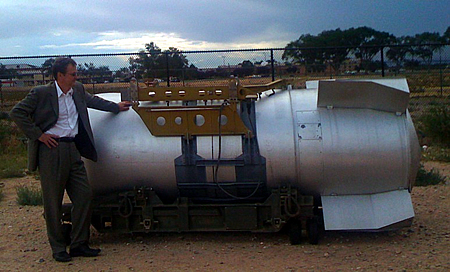 |
| The author next to a B53 shape outside the Atomic Museum in Albuquerque, NM. This open-air display is located at these coordinates: 35° 3’54.78″N, 106°32’7.09″W. |
.
By Hans M. Kristensen
The National Nuclear Surety Administration (NNSA) has announced that it has authorized the Pantex Plant in Texas to begin dismantlement of the B53 nuclear bomb.
Everything about the B53 is big: it weighs as much as a minivan and has an explosive yield of nine megatons, equivalent to 600 Hiroshima bombs.
Initially designed to annihilate Soviet cities, the large yield later earned the B53 one of the longest careers in the U.S. nuclear arsenal as a nuclear shovel; literally to dig up Soviet underground command bunkers. The mission was seen as so important that the B53 was even saved from an earlier retirement and allowed to serve for another decade until 1997 even though the Pentagon knew it had serious safety and security flaws.
Characteristics
The B53 is a two-stage thermonuclear bomb with a nuclear yield of nine megatons. At 148 inches (3.8 m) long and 50 inches (1.3 m) in diameter, the whole bomb weighs approximately 8,850 pounds (4 tons).
| “Exploded” B53 Bomb Components |
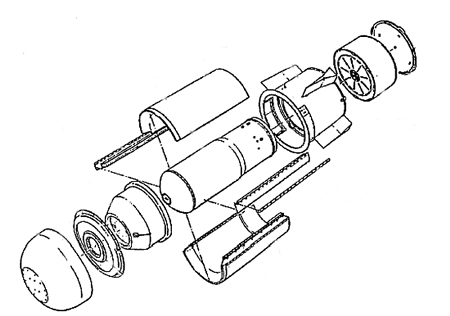 |
| The behemoth B53 weighed as much as a minivan and had a yield of nine megatons. It’s mission was to destroy deeply buried facilities with enormous radioactive fallout as a consequence. Drawing obtained under the Freedom of Information Act. |
.
Approximately 340 B53s of two versions (Mod 0 and Mod 1) were produced between 1962 and 1965. The bomb weighs as much as a minivan and could only be delivered by the B-52 bomber, each of which could carry two of the behemoth weapons.
The B53 only had a laydown option and was timer armed and fired so the delivery bomber had time to get away before detonation.
The large yield could destroy facilities buried 750 feet (230 meters) underground.
History
The B53 was on continuous airborne alert onboard B-52 bombers between 1962 and 1968, when about a dozen bombers were kept in the air 24 hours a day loaded with fully ready nuclear weapons to ensure the Soviet Union couldn’t disarm the United States in a first strike. After the airborne alert was canceled, the B53 was on ground-alert until retirement first began in 1987.
But that retirement coincided with the retirement of the high-yield Titan II ICBM in June 1987, another nine-megaton weapon used to hold Soviet underground facilities at risk. So the Joint Chiefs of Staff in March 1987 directed Strategic Air Command to return B53s to B-52 bombers on alert:
“In order to hold selected deeply targets at risk in all scenarios, a day-to-day alert capability is required. The current capability will be lost when the last Titan II ICBM is deactivated on Jun [sic] 87. Therefore, a B53 ALFA Alert capability must be developed as soon as possible.”
One of these targets probably was the nuclear command and control center under Kosvinsky Mountain in central Russia.
The B53 stayed on alert until 1991, when the bomber ground alert was finally cancelled.
Unsafe but Important
The B53 was not built with modern safety features, although it was one-point safe (detonation of any one chemical high explosives would not produce a nuclear yield). And over its many years in the stockpile some basic safety design features were added to the weapon to enhance nuclear explosive safety, for example to prevent accidental electrical energy from lightning to trigger the weapon. But the B53 did not have Enhanced Nuclear Detonation Safety (ENDS), Insensitive High Explosive (IHE), Fire-Resistant Pit (FRP), Protective Action Link (PAL), or Command Disable (CD).
The government had known about safety issues in the B53 “for twenty years,” former Sandia Director Paul Robinson later stated. But holding a few high-priority Soviet underground targets at risk was considered so important that safety requirements were waived, allowing the B53 to remain in the stockpile.
Legislation passed by Congress in 1992 specified three modern safety features that should be incorporated into all U.S. nuclear warheads: ENDS; IHE; FRP. The nuclear weapons stockpile plan from early 1993 directed the retirement of all warheads that lacked ENDS.
So in July 1993, then DOE Deputy Assistant Secretary for Military Application (Defense Programs) Winford Ellis “strongly recommended” to Harold Smith, the Assistant to the Secretary of Defense (Atomic Energy), that the B53 bomb be retired “at the earliest possible date.” The weapon “has no assured level of nuclear safety in a broad range of multiple abnormal environments.”
In addition to safety issues, the B-52 bomber was no longer considered capable of penetrating the most advanced air defense systems, so U.S. Strategic Command wanted a modern nuclear bunker-buster capability on the B-2 stealth bomber.
| The B53 Replacement: The B61-11 |
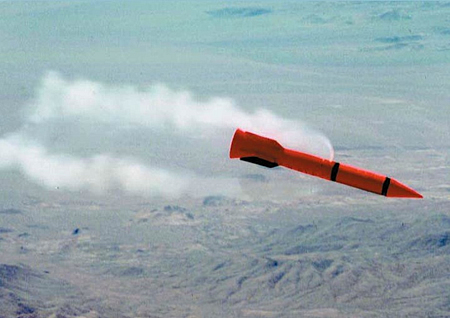 |
| The B-2 delivered B61-11 nuclear earth-penetrator (above, with spin motors in drop test) replaced the B-52 delivered B53 in 1997, improving the ability to penetrate modern air defenses and attack deeply buried facilities such as Russian command bunkers. |
.
The September 1994 NPR recommended replacing the B53 with a new bunker-buster, which eventually became the B61-11, a modified version of the B61-7 with earth-penetrating capability and increased yield. As the B61-11 entered the stockpile in 1997 on the B-2 bomber, the B53 was finally retired for the second time.
Only one other warhead, the W62 on the Minuteman III ICBM, had worse surety features than the B53. The W62 was allowed to remain in service until 2009.
That Good Old Nuclear Secrecy
Now, don’t hold your breath to be told how many B53s are being dismantled. After the Obama administration in May declassified the entire history of the size of the nuclear weapons stockpile as well as the number of warheads dismantled each year, mysterious national security now requires the government to keep secret the number of B53s to be dismantled at Pantex. Some things never change.
Excessive secrecy aside, the number of B53s to be dismantled is approximately 36.
This publication was made possible by a grant from Carnegie Corporation of New York and Ploughshares Fund. The statements made and views expressed are solely the responsibility of the author.
Nuclear De-Alerting Panel at the United Nations
 |
| Panelists from left: Hans M. Kristensen (FAS), John Hallam (Nuclear Flashpoint), Dell Higgie (New Zealand Ambassador for Disarmament), Christian Schoenenberger (Swiss UN Mission), Col Valery Yarynich (Institute of the United States and Canada, Russian Academy of Sciences), Stephen Starr (Physicians for Social Responsibility) |
.
By Hans M. Kristensen
On Wednesday, October 13th, I gave a briefing at the United Nations on the status of U.S. and Russian nuclear forces in the context of the interesting article Safe and Smaller recently published in Foreign Affairs.
One of the co-authors, Valery Yarynich, a retired colonel who served at the Center for Operational and Strategic Studies of the Russian General Staff, spoke about the main conclusion of the article: that is possible to significantly reduce the alert-level of U.S. and Russian strategic nuclear weapons without creating risks of crisis instability.
That conclusion directly contradicts the Obama administration’s recently completed Nuclear Posture Review, which rejected a reduction of the alert rates for land- and sea-based ballistic missiles because, “such steps could reduce crisis stability by giving an adversary the incentive to attack before ‘re-alerting’ was complete.”
The panel coincided with the meeting of the First Committee of the General Assembly, during which New Zealand submitted a resolution on decreasing the operational readiness of nuclear weapons.
This publication was made possible by a grant from Carnegie Corporation of New York and Ploughshares Fund. The statements made and views expressed are solely the responsibility of the author.
Scrapping the Safe Nuke?
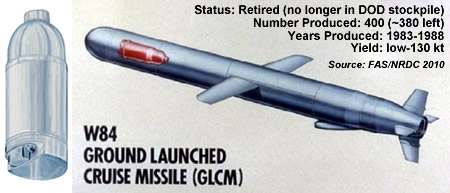 |
| The compact W84 warhead (left) was designed to be delivered by the ground-launched cruise missile. Some 380 W84s are awaiting dismantlement – or reuse. |
.
By Hans M. Kristensen
The National Nuclear Security Administration (NNSA) recently announced that disassembly of the W84 warhead has begun at the Pantex Plant in Texas.
This marks the final phase for a group of 400 warheads that were at the center of the Cold War in Europe as part of NATO’s Double Track Decision in 1979 to deploy intermediate-range weapons in response to Soviet deployments. The W84 armed the Ground-Launched Cruise Missile (GLCM) that was eliminated by the 1987 INF Treaty.
Redundant before production was completed in 1988, the W84 spent the rest of its life on shelves in military warehouses in the United States. The NNSA press release states that the W84 “remains in the inactive stockpile,” but the weapon was formally retired in 2006-2007, and neither the DOE budget request for FY2011 nor the latest Stockpile Stewardship Management Plan (SSMP) lists the W84 as part of the DOD stockpile. NNSA told me they would correct the press release.
The W84 was and probably is the safest of all the warhead types produced by the United States. It is equipped with more safety and security (surety) features than any other warhead: Insensitive High Explosives; Fire Resistant Pit; Enhanced Nuclear Detonation Safety (ENDS/EEI) with detonator stronglinks; Command Disable; and the most advanced Permissive Action Link (PAL G).
| Relative Surety of U.S. Nuclear Warheads |
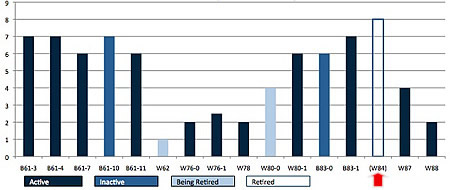 |
| The W84 is the equipped with more safety and security features (surety combined) than any other warhead in the U.S. stockpile. The W84 was retired in 2006-2007. |
.
It may seem as an irony that the safest warhead is being scrapped at a time when the administration is asking Congress to authorize billions of dollars to increase the safety and security of the remaining warheads in the stockpile. But there is a twist.
A few years ago, dismantlement at Pantex would have meant the end for the W84. But the Obama administration’s Nuclear Posture Review decided that the “full range of LEP approaches will be considered: refurbishment of existing warheads, reuse of nuclear components from different warheads, and replacement of nuclear components.”
As a result, the W84 – and all other retired warheads currently in line for dismantlement – “will be assessed for reuse applications as appropriate,” NNSA told me.
Therefore, they said, “it would be premature to assume that components from the W84 operations will be for immediate disposal (scrapping).”
So who knows, one day the W84 – or components of it – might be deployed once again as part of a replacement warhead.
This publication was made possible by a grant from Carnegie Corporation of New York and Ploughshares Fund. The statements made and views expressed are solely the responsibility of the author.
DF-21C Missile Deploys to Central China
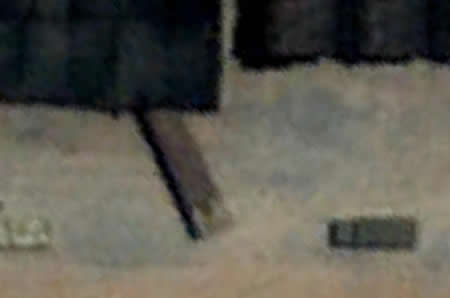 |
| China’s new DF-21C missile launcher shows itself in Western China. Image: GoogleEarth |
.
By Hans M. Kristensen
The latest Pentagon report on Chinese military forces recently triggered sensational headlines in the Indian news media that China had deployed new nuclear missiles close to the Indian border.
The news reports got it wrong, but new commercial satellite images reveal that launch units for the new DF-21C missile have deployed to central-western China.
New DF-21C Launch Units
Analysis of commercial satellite imagery reveals that launch units for the road-mobile DF-21C medium-range ballistic missile now deploy several hundred kilometers west of Delingha in the western part of central China.
| Location of DF-21C Launch Units |
 |
| For larger versions of the two middle satellite images, click here and here. Images: GoogleEarth and chinamil.com.cn |
In one image, taken by the GeoEye-1 satellite on June 14, 2010, two launch units are visible in approximately 230 km west of Delingha. The units are dug into the dry desert slopes near Mount Chilian along national road G215. Missile launchers, barracks, maintenance and service units are concealed under large dark camouflage, which stands out clearly in the brown desert soil.
The eastern launch unit (38° 6’37.75″N, 94°59’2.19″E) includes a central area with red barracks clearly visible below the camouflage, which probably also covers logistic units such as communications vehicles, fuel trucks, and personnel carriers. An 88×17 meter garage of brown camouflaged probably covers the launcher service area, with five 15-meter garages nearby probably housing the TELs. Approximately 130 meters north of the central area, brown camouflage and dirt barriers possibly house the unit’s remote fuel area. Two launch pads are visible, one only 180 meters from the main section, the other on the access road leading to national road G215.
The western launch unit (38° 9’32.82″N, 94°55’37.02″E) is located approximately 7 km further west about 2.4 km to the north of national road G215. The unit consists of four sections: personnel barracks (almost 100 with more possibly under camouflage); a logistic vehicles area; a launcher service area with a 90×33 meter camouflage and four garages; and what is possibly a remote fuel storage area. A launch pad is located along the access road close to G215.
The satellite image shows what appears to be a DF-21C entering or leaving the camouflaged launcher service area. The characteristic nose cone of the missile canister embedded into the rear of the driver cockpit is clearly visible, with the rest of launcher probably covered by a tarp.
This is, to my knowledge, the first time that the DF-21C has been identified in a deployment area. In 2007, I used commercial satellite images to describe the first visual signs of the transition from DF-4 to DF-21 at Delingha. A second article in 2008 described the extensive system of launch pads that extends west from Delingha along national road G215 past Da Qaidam.
There are five launch pads within five miles of the two launch units, with dozens other pads along and north of G215 in both directions.
More Invulnerable but with Limits
China’s ongoing modernization from old liquid-fuel missiles to new solid-fuel missiles is getting a lot of attention. The new systems are more mobile and thus less vulnerable to attack. Yet the satellite images also give hints about limitations.
First, the launch units are large with a considerable footprint that covers an area of approximately 300×300 meters. They are manpower-intensive requiring large numbers of support equipment. This makes them harder to move quickly and relatively easy to detect by satellite images.
| DF-21C Launch Unit on the Move |
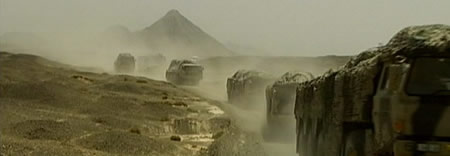 |
| The DF-21C medium-range ballistic missile may be more mobile and harder to target than older missiles, but it still relies on a large support unit that can be detected. Image: CCTV-7 |
.
Individual launchers of course would be dispersed into the landscape in case of war. But although the road-mobile launcher has some off-road capability, it requires solid ground when launching to prevent damage from debris kicked up by the rocket engine. As a result, launchers would have to stay on roads or use the pre-made launch pads that stand out clearly in high-resolution satellite images. Moreover, a launcher would not simply drive off and launch by itself, but need to be followed by support vehicles for targeting, repair, and communication.
Indian News Media (Mis)reporting
The deployment of DF-21 missiles caused constipation in Indian last month after the 2010 Pentagon report of Chinese military forces stated that China is replacing DF-4 missiles with DF-21 missiles to improve regional deterrence. The statement was contained in a section dealing with Chinese-Indian affairs and was picked up by the Press Trust of India, which mistakenly reported that the Pentagon report stated that, “China has moved advanced longer range CSS-5 [DF-21] missiles close to the border with India.” The Times of India even wrote the missiles were being deployed “on border” with India.
| India News Media Makes a Bad Situation Worse |
 |
| The India news media significantly misreported what the Pentagon report said about the Chinese DF-21 deployment. Not the finest hour of Indian journalism. |
.
Not surprisingly, the misreporting triggered dramatic news articles in India, including rumors that the Indian Strategic Forces Command was considering or had already moved nuclear-capable missile units north toward the Chinese border in retaliation.
The Pentagon report, however, said nothing about moving DF-21 missiles close to or “on” the Indian border. Here is the actual statement: “To improve regional deterrence, the PLA has replaced older liquid-fueled, nuclear-capable CSS-3 intermediate-range ballistic missiles with more advanced and survivable solid-fueled CSS-5 MRBM….” The statement echoes a statement in the 2009 report: “The [People’s Liberation Army] has replaced older liquid-fueled nuclear-capable CSS-3 [DF-4 medium-range ballistic missiles] MRBMs with more advanced solid-fueled CSS-5 MRBMs in Western China.”
The sentence appears to describe the apparent near-completion of China’s replacement of DF-4 missiles with DF-21 missiles, probably at two army base areas in Hunan and Qinghai provinces, a transition that has been underway for two decades. The two deployment areas are each more than 1,500 kilometers from the Indian border.
Range Confusion
The unclassified ranges of Chinese DF-21 versions published by the U.S. intelligence community are 1,770+ km (1,100+ miles) for the two nuclear versions (DF-21, CSS-5 Mod 1; and DF-21A, CSS-5 Mod 2). The DF-21A appears to have an extended range of 2,150 km. The dual-capable “conventional” DF-21C has a maximum range of 1,770 km, and the yet-to-be-deployed DF-21D anti-ship missile has a shorter range of 1,450+ km. Private publications frequently credit the DF-21D with a much longer range (CSBA: 2,150 km; sinodefence.com and Wikipedia: 3,000 km).
DOD maps are misleading because they depict missile ranges measured from the Chinese border, as if the launchers were deployed there rather than at their actual deployment areas far back from the border. The 2008 report, for example, includes a map essentially showing China’s border extended outward in different colors for each missile range. The result is a DF-21 range of about 3,000 km if measured from the actual deployment areas.
| DF-21 Range According to 2008 Pentagon Report |
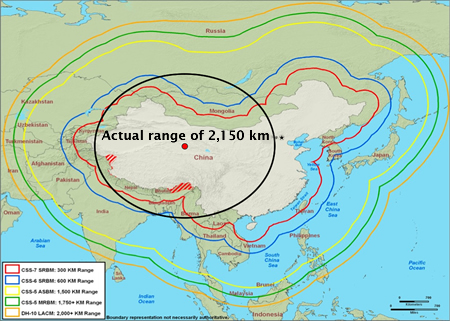 |
| The 2008 Pentagon report on China’s military forces misrepresents missile ranges. |
.
The 2010 report is even worse because it shows the ranges without the border contours as circles but measured from the most extreme border position. The result is a map that is even more misleading, suggesting a DF-21 range of as much as 3,500 km from actual deployment areas. The actual maximum range is 2,150 km for DF-21A (CSS-5 Mod 2), and 1,770 km for the DF-21C.
| DF-21 Range According to 2010 Pentagon Report |
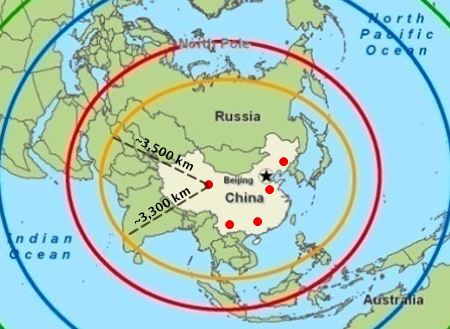 |
| The 2010 Pentagon report on Chinese military issues greatly exaggerates the reach of the DF-21 by drawing a ring around China that doesn’t reflect actual deployment areas. |
.
Although a DF-21 launcher could theoretically drive all the way up to the border to launch, the reality is that DF-21 bases and roaming areas are located far back from the border to protect the fragile launchers from air attack. DOD maps should reflect that reality.
Additional Resources: earlier China blogs; Chinese Nuclear Forces and U.S. Nuclear War Planning
This publication was made possible by a grant from Carnegie Corporation of New York and Ploughshares Fund. The statements made and views expressed are solely the responsibility of the author.
Rasmussen: Lay Short-Range Nuclear Weapons Thinking to Rest

By Hans M. Kristensen
The next steps in European security should include additional reductions in the number short-range nuclear weapons in Europe, according to a video statement issued by NATO General Secretary Anders Fogh Rasmussen:
“We also have to make progress sooner or later in our efforts to reduce the number of short-range nuclear weapons in Europe. NATO has cut the number of short-range nuclear weapons in Europe by over 90 percent. But there are still thousands of short-range nuclear weapons left over from the Cold War and most of them are in Russia. NATO is not threatening Russia and Russia is not threatening NATO. Time has come to lay this Cold War thinking to rest and focus on the common threats we face from outside: terrorism, extremism, narcotics, proliferation of missiles, weapons of mass destruction, side by side, and piracy. We can make progress of all three tracks – missile defense, conventional forces, and nuclear weapons – and create a secure Europe. It is time to stop spending our time and resources watching each other and look outward at how to reinforce our common security hope.”
That vision appears similar to the “new regional deterrence architecture” that several recent Obama administration reviews concluded would permit a reduction of the role of nuclear weapons. With that in mind, and Rasmussen’s conclusion that “Russia is not threatening NATO” and that the “time has come to lay this Cold War thinking to rest,” it should be relatively straightforward for him to recommend a withdrawal of the remaining U.S. nuclear weapons from Europe.
Unfortunately, rather than taking the initiative to complete the withdrawal of U.S. short-range nuclear weapons from Europe – a process that have been underway now for two decades but held up by Cold War thinking and NATO bureaucrats, Rasmussen instead appears to weave the future of the weapons in Europe into a web of new conditions that must be met first. In a speech at the Aspen Institute in Rome, Rasmussen described his three-track vision of collaborating with Russia on missile defenses, conventional weapons negotiations, and reducing short-range nuclear weapons:
“I think we have before us three tracks, which, if we follow them, will lead to a different, better and safer Europe: where we don’t look over our shoulders for someone else’s tanks or fighters; where missile defences bind us together, and protect us too; and where steadily, the number of short-range nuclear weapons on the continent is going down.”
Nuclear reductions appear to be the third track, after missile defense collaboration and conventional arms negotiations with Russia. For two decades, NATO has insisted the U.S. nuclear weapons in Europe have no military mission and that they’re not linked to Russia. The alliance has repeatedly been capable of and willing to make unilateral reductions – even complete withdrawal from Greece and the United Kingdom – without conditions or demanding reductions in Russian short-range nuclear weapons.
So why start linking reductions to Russia now?
Doing so seems to turn back the clock to the Cold War when NATO looked to Russia’s military forces to determine its nuclear posture in Europe. If the conclusion that “Russia is not threatening NATO” is more than words, then why make a three-track vision that assumes that Russia’s short-range nuclear weapons threaten NATO? Because the short-range weapons are not covered by any arms control regime, Rasmussen explains, the lack of transparency “makes allies cautious.”
There are certainly many good reasons to want to try to secure and reduce Russian short-range nuclear weapons. But if Russia is not threatening NATO, then Russian and U.S. short-range nuclear weapons should be addressed as a generic arms control challenge and not one that is linked to whether the U.S. has nuclear weapons in Europe or not.
| Did They Lay Cold War Nuclear Thinking to Rest? |
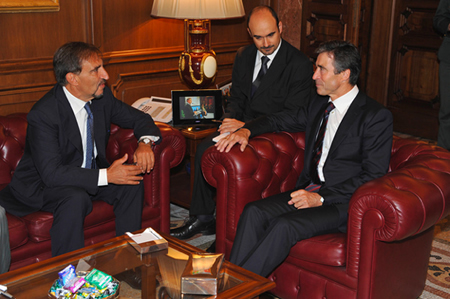 |
| During his meeting with Italian defense minister Ignazio La Russa, did Rasmussen discuss the possibility of a withdrawal of U.S. nuclear weapons from Europe, including Italy, or just the threat of Russian short-range nuclear weapons? |
.
If NATO unilaterally withdrew the remaining U.S. nuclear weapons from Europe, what would happen?
Would Russia decide that it didn’t have to reduce its short-range nuclear weapons? Hardly, since those forces seem to be more tied to Russia’s perception of NATO’s conventional superiority and a need to safeguard the long border with China. Besides, many of the Russian weapons are so old that they’re likely to be retired soon.
Would Russia get an advantage in a hypothetical crisis with NATO? Hardly, since it would require that Russia ignores NATO’s conventional superiority and U.S., British, and French long-range nuclear forces.
Would Russia decide that it had more freedom to deploy conventional forces on NATO periphery? Hardly, since such decisions seem to be made regardless of U.S. nuclear weapons in Europe.
Would Iran somehow conclude that it could take additional steps acquiring nuclear weapons capability? Hardly, since its security assessment is not affected by whether the U.S. deploys nuclear weapons in Europe and it would still face serious consequences if it developed – certainly if it used – nuclear weapons.
Would Turkey and Eastern European NATO members conclude that NATO’s security guarantee was no longer credible and begin building nuclear weapons? Hardly, since their assurance is much more determined by conventional forces and political relations, and, to the limited extent nuclear forces play any role, the long-range forces of the United States, Britain, and France, would be more than adequate for any realistic scenario. Moreover, any NATO member country that began to develop nuclear weapons would face enormous pressure from the international community and from within NATO itself.
To the extent that some officials in some eastern European NATO countries feel uneasy about the inevitable withdrawal of U.S. short-range nuclear weapons from Europe, the obvious job for the Obama administration and the majority of NATO countries that favor a withdrawal is a concerted effort to educate those officials about the significant conventional and long-range nuclear capabilities that will continue to provide security when the short-range weapons are withdrawn. The revised Strategic Concept to be adopted at the Lisbon Summit in November is expected to reaffirm a role for nuclear weapons in NATO.
Rasmussen would do more for European security if he tried to decouple the future of U.S. nuclear weapons in Europe from the need to reduce and eventually eliminate short-range nuclear weapons in general. Doing so would indeed be to “lay this Cold War thinking to rest.”
This publication was made possible by a grant from Carnegie Corporation of New York and Ploughshares Fund. The statements made and views expressed are solely the responsibility of the author.
China’s Bulava?
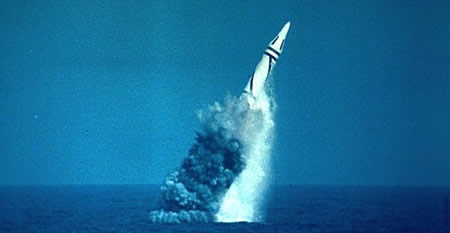 |
.
By Hans M. Kristensen
Similar to Russia’s troubled Bulava sea-launched ballistic missile, the Pentagon’s latest report on China’s military power reveals that Chinese efforts to develop a new sea-based nuclear missile have run into problems.
Other nuclear force developments described in the Pentagon’s delayed annual report on China’s military power, now renamed Military and Security Developments Involving the People’s Republic of China, include a slow deployment of new land-based mobile missiles and nuclear command and control challenges.
Naval Nuclear Programs
While the first boat of a small class of new Jin-class (Type 094) sea-launched ballistic missile submarines “appears ready” and up to four more may be building, development of the long-range ballistic missile Julang-2 for the class is said to have “encountered difficulty.”
The report reveals that the new missile has been “failing several of what should have been the final round of flight tests.”
| Julang-2 “Dry” Launch |
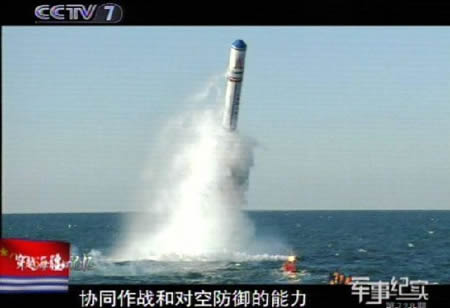 |
| The Pentagon says China’s new sea-launched ballistic missile has failed several tests. |
.
The latest setback continues the problems that have characterized China’s naval nuclear program over the years. The first SSBN program (Type 092) only produced one boat, the Xia, which has never sailed on a deterrent patrol. Even following a recent lengthy submarine overhaul, the Pentagon describes the operational status of the Xia’s Julang-1 missile system as “questionable.”
The nuclear-powered attack submarine program also seems challenged, with only two Shang-class (Type 093) boats operational – the same as last year – and four old Han-class (Type 091) boats still in service. Instead, the focus of the nuclear attack submarine program appears to have shifted to building a new class, the Type 095. The Pentagon report projects that “up to five” Type 095s may be added “in the coming years.”
Land-Based Nuclear Missiles
Introduction of new land-based mobile ballistic missiles continues, but at a slow pace. The DF-31 program appears stagnant at “<10” missiles, the same as reported last year. The number of intercontinental DF-31As has only increased by a couple of missiles, from “<10” last year to “10-15” in this year’s report.
| DF-31A Parading in Beijing |
 |
| Deployment of the DF-31 and DF-31A has been slow, new Pentagon report shows. |
.
Probably as a possible result of the slow deployment of the new DF-31, the number of old liquid-fueled DF-3A and DF-4 missiles remain the same as last year.
Despite a strong display at the military parade in Beijing last year, the number of DF-21 launchers has not increased compared with last year. The number of missiles is a little higher, 85-90 missiles versus 60-80, probably reflecting addition of conventional DF-21C versions.
The report continues previous years’ predictions that a new road-mobile ICBM may be under development, possibly a reference to the elusive DF-41 or another system. The new missile is described as “possibly capable of carrying a multiple independently targeted re-entry vehicle (MIRV).”
Previous reports have reported development of MIRV technology for many years, but always concluded that MIRV technology for mobile missiles would be too difficult and expensive. The reference to a road-mobile ICBM MIRV capability is new, although it comes with a lot of caveats: “may be under development,” and “possibly capable of carrying” MIRV.
A MIRV system would, if deployed, represent a significant change in Chinese nuclear employment strategy. Russia and the United States deployed MIRVed systems to improve targeting against military targets. A secondary reason – for Britain it was probably the primary reason – was to overwhelm missile defenses.
Rather than increased targeting, the Chinese motivation for pursuing MIRV probably is the emergence of increasingly advanced U.S. ballistic missile systems. Phase 4 of the Obama administration’s Phased Adaptive Approach (PAA) includes an anti-ballistic missile defense capability against ICBMs from around 2020. This may push China further toward MIRV.
| Julang-1 Loading |
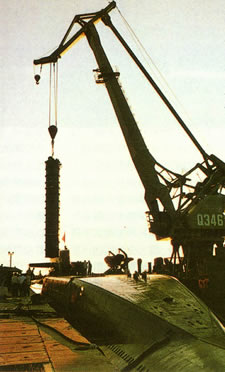 |
| Could loading of nuclear missiles in a crisis affect crisis stability? |
Nuclear Command and Control
As were the case with the 2009 report, the 2010 report underscores the command and control issues facing Chinese leaders. “The introduction of more mobile systems will create new command and control challenges for China’s leadership, which now confronts a different set of variables related to deployment and release authorities.”
One of these is the emerging SSBN force, an almost entirely new form of nuclear deployment in Chinese posturing. The report states that “the PLA has only a limited capacity to communicate with submarines at sea, and the PLA Navy has no experience in managing a SSBN fleet that performs strategic patrols with live nuclear warheads mated to missiles.”
Chinese SSBNs have never performed a strategic deterrent patrol (none were conducted in 2009), and if current Chinese doctrine is any indication it is doubtful that the SSBNs will deploy with “live nuclear warheads mated to missiles” in peacetime. But the absence of operational experience and the limited communication capability raises serious questions about how inadequate proficiency and launch control procedures might create problems in a crisis.
The report raises similar issues with the emergency of the new generation of land-based mobile missiles. Although China has operated medium-range mobile missiles for decades, the delegation of launch authority in a crisis to units with quicker-launch solid-fuel long-range missiles raises questions about use control, crisis stability, and misunderstandings.
| DF-31A on Launch Pad |
 |
| How will quicker-firing long-range missiles such as the DF-31A affect command and control and delegation of launch authority? |
.
And there “is little evidence,” the Pentagon concludes, “that China’s military and civilian leaders have fully thought through the global and systemic effects that would be associated with the employment of these strategic capabilities.”
Despite these issues and speculations in previous annual Pentagon reports and the public about possible changes to Chinese nuclear doctrine, particularly conditions to its no-first-use policy, the 2010 report concludes that, “there has been no indication that national leaders are willing to attach such nuances and caveats to China’s ‘no first use’ doctrine.”
See also: previous blogs about China
This publication was made possible by a grant from Carnegie Corporation of New York and Ploughshares Fund. The statements made and views expressed are solely the responsibility of the author.
